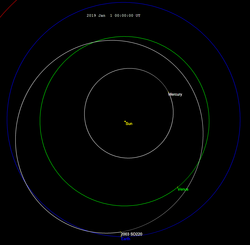 Radar image of 2003 SD220 from Arecibo Observatory on 16 December 2018 | |
| Discovery [1] [2] | |
|---|---|
| Discovered by | LONEOS |
| Discovery site | Anderson Mesa Stn. |
| Discovery date | 29 September 2003 |
| Designations | |
| (163899) 2003 SD220 | |
| 2003 SD220 ·2000 AD229 | |
| NEO · PHA · Aten [1] [2] | |
| Orbital characteristics [1] | |
| Epoch 4 September 2017 (JD 2458000.5) | |
| Uncertainty parameter 0 | |
| Observation arc | 15.96 yr (5,828 days) |
| Aphelion | 1.0019 AU |
| Perihelion | 0.6533 AU |
| 0.8276 AU | |
| Eccentricity | 0.2106 |
| 0.75 yr (275 days) | |
| 322.67° | |
| 1° 18m 33.12s / day | |
| Inclination | 8.4591° |
| 274.05° | |
| 326.47° | |
| Earth MOID | 0.0174 AU ·6.8 LD |
| Physical characteristics | |
| 0.80±0.02 km [3] 1.03 km (calculated) [4] | |
| 285±5 h [5] [a] 11.9±0.2 days | |
| 0.20 (assumed) [4] 0.31±0.04 [3] | |
| S (assumed) [4] | |
| 13.5 (2021 peak) | |
| 17.3 [1] [4] ·17.36 [3] | |
(163899) 2003 SD220 is a sub-kilometer asteroid and tumbling slow rotator, classified as near-Earth object and potentially hazardous asteroid of the Aten group, which orbit the Sun between Venus and Earth. Its orbital period of 0.75 years means that it orbits the Sun about 4 times for every 3 of the Earth. It was discovered on 29 September 2003, by astronomers of the Lowell Observatory Near-Earth-Object Search at Anderson Mesa Station near Flagstaff, Arizona. [2]














